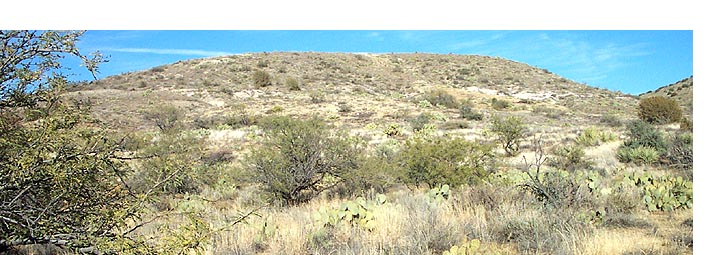BADGER SPRINGS AREA
 North west of the trail area there is a hill with significant outcrop of
light gray tuff exposed. This tuff is interesting because it has
large and small clasts of only slightly rounded granodiorite imbedded
in it...see pictures below.
A sample at N34, 14, 25.7 W112, 05, 47.2 shows, no fizz, or iron indication at all and porous,
with the below clasts; This tuff is not welded but harder than the large tuff
deposits at BCC. Only this hill has a significant layer of this tuff.
North west of the trail area there is a hill with significant outcrop of
light gray tuff exposed. This tuff is interesting because it has
large and small clasts of only slightly rounded granodiorite imbedded
in it...see pictures below.
A sample at N34, 14, 25.7 W112, 05, 47.2 shows, no fizz, or iron indication at all and porous,
with the below clasts; This tuff is not welded but harder than the large tuff
deposits at BCC. Only this hill has a significant layer of this tuff.
Tuff hill ...red line is main tuff layer.
1. 1/4 to 1 inch clasts of non-rounded granodiorite.
2. 1/10 to 1/8 inch opaque quartz crystals.
3. Scattered 1/8 inch flakes of golden mica (Probably altered biotite).
3. MM size grains of light gray volcanic ash.
The surrounding hills have only small amounts
of this tuff. The stratagraphic relationship in the area is...basement
is Badger Springs Granodiorite. Above that is roof pendants of
older schist then tuff (probably Miocene) above that with a top layer
of younger mixed alluvial. The researchers have two competing
theories as to the nature of the hill.
1. This hill could contain a covered rhyolitic vent that ripped out
some of the BS granodiorite below and blew it out the vent
along with the much finer ash.
2. The hill is nothing more than a reworked tuff erosion remnant
from a distant unknown rhyolitic volcano.
- Map location ...red line is tuff layer.
- pix1 ...slightly layered tuff
- pix2 ...imbedded granodiorite boulder
- pix3 ...imbedded granodiorite boulders

